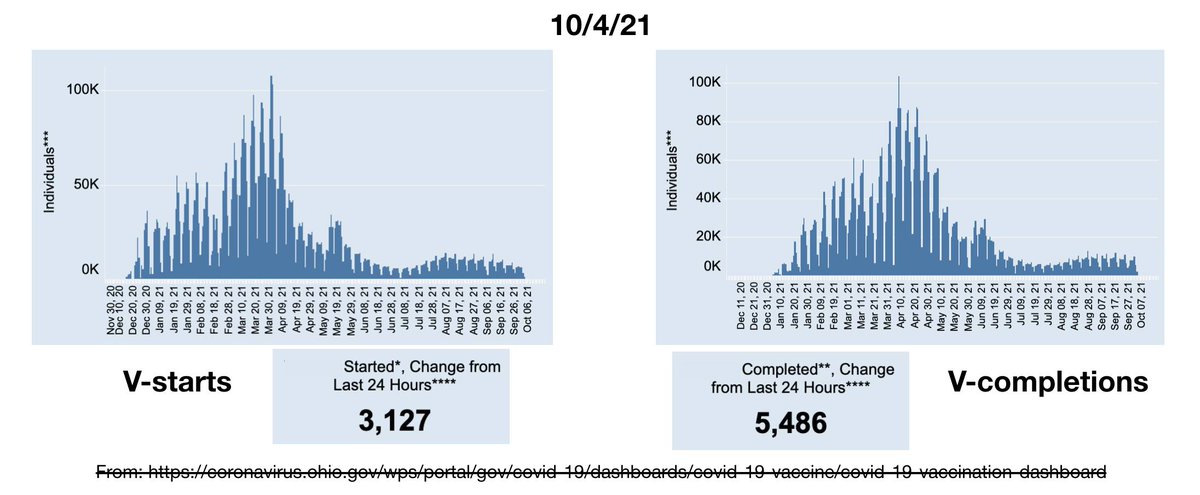
🧵 - Perspective.
Is Ohio 'on fire' with COVID right now?
Is Ohio 'on fire' with COVID right now?
Here we go again, the state is suddenly 'on fire' with COVID. Counties, institutions and businesses are suddenly reissuing mask mandates/advisories and panic is already ensuing.
Why?
Because this week's CDC Map of Fear update was a doozy, with most of the state now being at yellow (medium) and orange (high) alert levels (see below).
Because this week's CDC Map of Fear update was a doozy, with most of the state now being at yellow (medium) and orange (high) alert levels (see below).

But yet again, let us put what is happening in perspective. The CDC's Map is based only on 3 things, the number of 'cases' per 100K over 7 days, the number of new hospital admissions 'for' COVID-19 over 7 days & the % of staffed inpatient beds with a 'COVID' patient. That's it.
And the two hospital metrics have the power to trigger a county to 'high' level all on their own. This system allows for the absurd situation that there could be zero new cases, and still be at a 'high' level. It's that bad.
We all know 'cases' could be just about anything. Anyone with a positive test, without or without a symptom can be a 'case', or anyone with normal cold and flu symptoms can be a 'case', no test needed.
And the hospital metrics are even worse, particularly the new admissions metric. Right now, in fact, it is the new admissions metric that has almost fully fueled this new 'wave' of alarm across the state.
Outside of the green counties, only 10 of the 76 yellow and orange counties have not triggered the new admissions metric, while 3 counties in orange have ONLY triggered the admissions metric (Mahoning, Trumbull and Washington).
But let's put this hospital flood in perspective, shall we? In the following image, I have plotted days from 'onset' to hospital admission date for all of the new hospital admissions that have occurred in the 7 days that the CDC is using. 

To be clear about definitions, 'onset' is either the date when symptoms started, or, if asymptomatic, the date of the positive test.
In the state of Ohio, a state of ~11.7 million residents, over 7 days, there were a total of 521 new hospital admissions designated as COVID. That's less than 75 COVID admission per day for an entire state. For a bit more perspective, Ohio has ~24,000 total inpatient beds.
But wait, there's more.
Of those hospitalizations, 292 (56%) had onset on date of admission. You don't go to the hospital & get admitted the day you start feeling respiratory symptoms. These people weren't being admitted for C19, but incidentally testing positive upon admission for another condition.
We also have the even more absurd COVID hospitalizations where a person has onset AFTER admission to the hospital. These individuals, again, could not have been admitted FOR COVID.
Together, just these two 'impossible' categories comprise 63% of all supposed COVID hospital admissions in the state over those 7 days. That doesn't even take into account the 30 individuals who, somehow, have an 'unknown' date of hospital admission.
Nor does it include two individuals who had 'onset' more than a month before their supposed admission for COVID-19.
Again, the vast majority of the state has triggered to medium or high alert levels based on this one metric. Places of employment have already reinstituted mask mandates, county Health Departments are issuing advisories and the panic is starting to rise again.
Based on numbers that are vanishingly small, and clearly do not represent disease.
There is no new ‘wave’ of disease. There is no crisis.
#Ohio #InThisTogetherOhio #COVID19
There is no new ‘wave’ of disease. There is no crisis.
#Ohio #InThisTogetherOhio #COVID19
• • •
Missing some Tweet in this thread? You can try to
force a refresh














